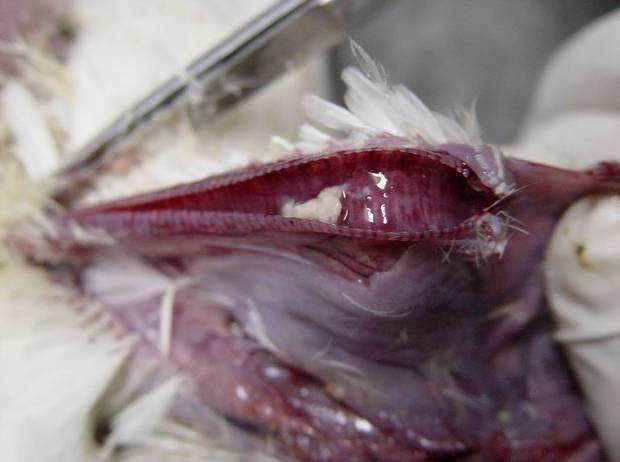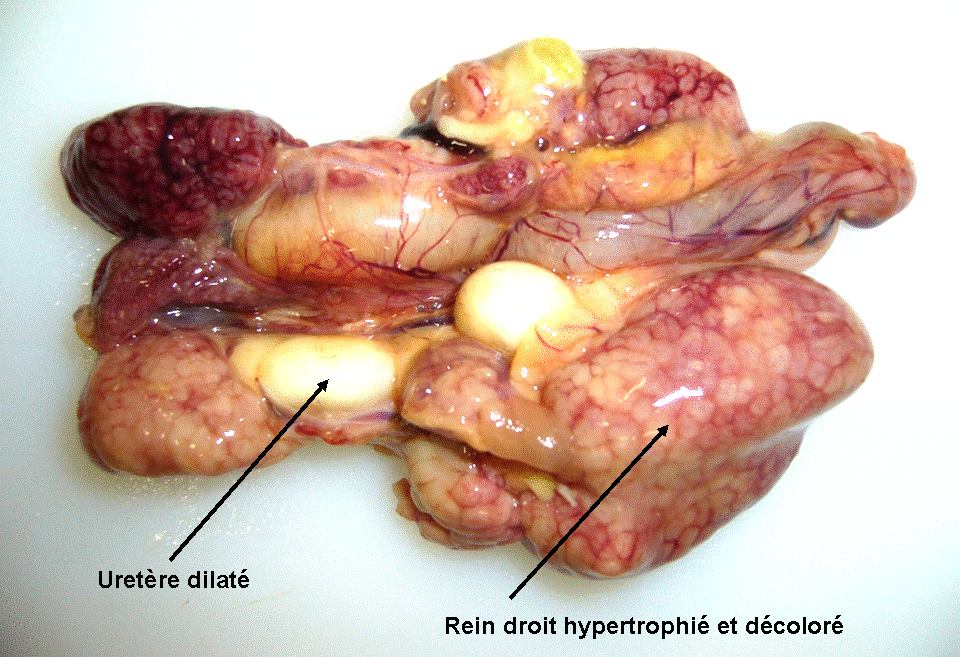Infectious bronchitis is a viral disease distributed worldwide, very frequent and highly contagious. It is of major economic importance, as it causes large losses in egg production and weight gain, and can also cause seizures at the slaughterhouse. It was first described in 1930 in the USA in its respiratory form, then in the 1940s for the reproductive form and in the 1960s for the renal form. Genital forms can also have a significant impact on laying.
The disease agent and its pathogenicity
The etiological agent is an 80-160 nm, single-stranded RNA, enveloped coronavirus. Spikes at the periphery of the the virion give the impression of a crown and have great antigenic importance. This virus has a strong capacity for evolution, by mutation or recombination of its long genome (> 30 kb). The virus is sensitive to most disinfectants. Viral particles can, however, survive for several months at negative temperatures.
At least a dozen serotypes are known, the most widespread in Europe being the “classic” Massachusetts serotype, the variant serotypes 793B, QX and Italy02. Cross-protection between serotypes is often weak, or even non-existent. Some have a tropism other than respiratory : genital or renal, in particular. The wide variety of serotypes and virulence of the strains, combined with high contagiousness, explain the persistence of the disease.
The virus first replicates in the respiratory tract epithelium and then spreads to the internal organs. It has a more pronounced tropism for epithelial cells in the active multiplication phase.
Epidemiological data
The virus has been detected in many birds, with no associated clinical signs : only the genus Gallus is susceptible. The role of species other than Gallus is not clear, whether or not they are a source of multiplication and contamination for farms. There are similar coronaviruses in turkey or pheasant. Birds of all ages are susceptible, but clinical signs are more severe in young birds : with age, kidney, oviduct and mortality decrease. Respiratory manifestations are most common in birds under 5 weeks of age.
IB is transmitted mainly by the respiratory tract, aerosols and faeces. Virulent materials consist of discarding and droppings. Transmission is horizontal, both directly (from sick birds to susceptible birds) and indirectly (through water, equipment,…).
- Viral shedding by discarding can lasts about 10 days ; however, fecal shedding can last up to 20 weeks.
- Cloacal samples will therefore be more relevant for detecting late viral excretion.
Clinical manifestations of the disease
Morbidity is close to 100%. Mortality is often low (except for the renal tropism strain). Incubation is short (18-36h).
Symptoms
They depend on the serotype and its tropism. Often, there are few signs, and animals heal spontaneously. Signs are more severe in youngs, with primary mortality. In adults, mortality is often caused by secondary infections.
- Respiratory signs : cough, wet tracheal rails or pump noise in youngs, sneezing, never hemorrhagic seromucosal nasal discharge, sometimes swollen sinuses and serous conjunctivitis with wet eyes.
They are mainly found in chicken. These signs may be accompanied by general symptoms in youngs. The often spontaneous healing in 2 weeks is accompanied by marked growth retardation. There are frequent complications of chronic kidney disease, especially in chickens at the end of fattening. In older laying hens, the signs are more discreet or even absent. - Reproductive signs : egg loss (10-70%), poor quality eggs (thin or absent, pale or rough shell, albumen too liquid, deformed eggs), oviduct lesions. The
passage of the virus on future laying hens less than 2 weeks old will, in addition to the respiratory signs, have disastrous consequences on egg laying (“false layers”). The presence of maternal antibodies can prevent these lesions from developing. The passage of Infectious Bronchitis at the beginning of egg laying causes a slight decrease in egg laying, which returns to normal in 1 to 2 weeks. An infection just after the peak egg laying usually has catastrophic consequences. The disease at the end of egg laying leads to the irreversible cessation of it. - Renal signs (with certain viral strains) : depression, intense thirst, wet faeces, mortality. Birds less than two weeks old have more severe nephritis and higher associated mortality.
It also multiplies in the gastrointestinal tract, but with few associated lesions.
Lesions
Tracheitis with mucus or caseous clusters also found in the primary bronchi, foam in the air sacs, nasal discharge in youngs, sometimes sinusitis, hypertrophy and paleness of the kidneys, sometimes with urate crystals, rupture of ovarian follicles in the abdomen, cystic oviduct in adults or atrophy in infected growing hens.


The diagnosis
Clinical diagnosis
Based on non-specific clinical and lesional signs and it is almost always necessary to use the laboratory. No laboratory technique is totally satisfactory to confirm infection with a specific serotype.
Laboratory diagnosis
Used for confirmation. RT-PCR or mainly serology is used. Samples are different depending on the age of the infection. Tracheal swabs or trachea can be used if the infection has lasted less than a week. If it is older, organs such as the lung, kidney, oviduct, caecal tonsils or cloacal swabs should also be submitted.
Differential diagnosis
Newcastle disease, infectious laryngotracheitis, infectious coryza, adenovirus. BI is to be considered in any egg-laying fall syndrome.
Disease prevention and control
There is no specific treatment for Infectious Bronchitis. Improving the comfort of the animals helps to accelerate their healing. Reasoned antibiotic therapy based on an antibiogram can limit secondary infections.
High levels of maternal antibodies reduce the severity of lesions during infection in the first few days of life.
Vaccination is effective. There are vaccines with live attenuated viruses, which can be administered by ocular route (not between 6 and 10 days), by nebulization, or in drinking water. There are also vaccines with inactivated viruses, injectable subcutaneously or intramuscularly.
Failure is possible if the choice of serotype is not relevant, if stress or other vaccination occurs at the same time, or if the nebulization is too coarse.
In chicken, live attenuated live virus vaccines are used ; inactivated virus vaccines are reserved for birds with a longer lifespan (layers, breeding birds).






